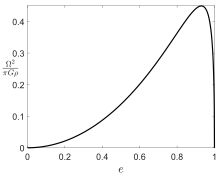Maclaurin spheroid
A Maclaurin spheroid is an oblate spheroid which arises when a self-gravitating fluid body of uniform density rotates with a constant angular velocity. This spheroid is named after the Scottish mathematician Colin Maclaurin, who formulated it for the shape of Earth in 1742.[1] In fact the figure of the Earth is far less oblate than this, since the Earth is not homogeneous, but has a dense iron core. The Maclaurin spheroid is considered to be the simplest model of rotating ellipsoidal figures in equilibrium since it assumes uniform density.
Maclaurin formula

For a spheroid with equatorial semi-major axis and polar semi-minor axis , the angular velocity about is given by Maclaurin's formula[2]
where is the eccentricity of meridional cross-sections of the spheroid, is the density and is the gravitational constant. The formula predicts two possible equilibrium figures when , one is a sphere () and the other is a very flattened spheroid (). The maximum angular velocity occurs at eccentricity and its value is , so that above this speed, no equilibrium figures exist. The angular momentum is
where is the mass of the spheroid and is the mean radius, the radius of a sphere of the same volume as the spheroid.
Stability
For a Maclaurin spheroid of eccentricity greater than 0.812670,[3] a Jacobi ellipsoid of the same angular momentum has lower total energy. If such a spheroid is composed of a viscous fluid, and if it suffers a perturbation which breaks its rotational symmetry, then it will gradually elongate into the Jacobi ellipsoidal form, while dissipating its excess energy as heat. This is termed secular instability. However, for a similar spheroid composed of an inviscid fluid, the perturbation will merely result in an undamped oscillation. This is described as dynamic (or ordinary) stability.
A Maclaurin spheroid of eccentricity greater than 0.952887[3] is dynamically unstable. Even if it is composed of an inviscid fluid and has no means of losing energy, a suitable perturbation will grow (at least initially) exponentially. Dynamic instability implies secular instability (and secular stability implies dynamic stability).[4]
See also
References
- Maclaurin, Colin. A Treatise of Fluxions: In Two Books. 1. Vol. 1. Ruddimans, 1742.
- Chandrasekhar, Subrahmanyan. Ellipsoidal figures of equilibrium. Vol. 10. New Haven: Yale University Press, 1969.
- Poisson, Eric; Will, Clifford (2014). Gravity: Newtonian, Post-Newtonian, Relativistic. Cambridge University Press. pp. 102–104. ISBN 978-1107032866.
- Lyttleton, Raymond Arthur (1953). The Stability Of Rotating Liquid Masses. Cambridge University Press. ISBN 9781316529911.